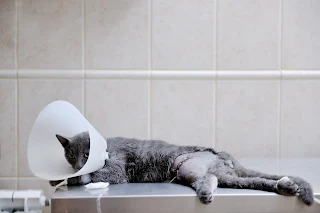Is Your Cat in Pain? Warning Signs Every Owner Should Know
As a cat owner, your feline friend can't tell you directly when they're not feeling well or are in discomfort. But that doesn't mean there aren't signs you can look for. Their behavior and actions can speak volumes about their health and wellbeing. Have you noticed your cat acting differently recently? Not using the litter box, hiding more often, not grooming as much? These can all be subtle cues that something may be wrong and your cat could be in pain.
Changes in Behavior: Withdrawal, Irritability, Aggression
If your usually friendly feline is suddenly sulking in the corner or swatting at you for no reason, it could be a sign they're in pain. Some things to watch out for:
- Withdrawal from social interaction. If your cat abruptly stops purring, cuddling or seems to want to be left alone, it could indicate they're not feeling well.
- Irritability or aggression. Lashing out, especially for minor things that normally wouldn't bother them can be a symptom of pain in cats. Excessive meowing, especially at night, can also be a clue.
- Changes in grooming or litter box habits. If your cat stops grooming themselves regularly or has accidents outside the litter box, it's worth investigating further. Pain can make normal behaviors difficult or undesirable.
- Appetite changes. Both eating much less or much more can be a warning sign in cats. If meals are skipped or gobbled up, pain may be the culprit.
- Difficulty moving around. Hopping instead of walking, stiffness, limping or favoring one side can all point to pain in cats, especially in older felines or those with arthritis.
Don't ignore these warnings. Schedule a vet visit right away for an exam and diagnosis. The sooner pain is properly managed in cats, the better their quality of life will be. With treatment, you'll have your sweet, gentle companion back to their usual self in no time.
Changes in Activity Levels and Posture
If your usually energetic cat seems less active lately or is walking or sitting differently, it could indicate they're in pain. Pay close attention to their behavior and posture for these warning signs:
- Less interest in play or interaction. If your cat isn't pestering you for attention or skipping their usual playtime, something may be wrong.
- Difficulty jumping up or navigating stairs. If climbing onto furniture or bounding up steps is suddenly a challenge, it can point to pain in their limbs, paws or spine.
- Limping or favoring a limb. Obvious lameness is alarming and needs to be addressed by a vet. More subtle changes in gait or how much weight they put on a paw can also indicate discomfort.
- Hunched or tense posture. If your cat seems stiff, is walking very slowly or deliberately, or is sitting in an unusual position, it may be because movement causes pain.
- Lack of grooming. Most cats are fastidious self-groomers, so if your cat isn't cleaning themselves properly it can be a sign they don't feel well.
- Aggressive behavior. Sometimes pain can make cats irritable, causing them to hiss, swat or bite when touched or handled. This is their way of protecting a sore area.
If you notice any combination of these signs in your cat, don't delay in having them checked out by the vet. The sooner pain is diagnosed and treated, the sooner your cat can get back to their usual happy, active self. Early diagnosis and treatment is key to keeping your feline companion pain-free and by your side for years to come.
Changes in Eating and Drinking Habits
One of the first signs your cat may not be feeling well is a change in their eating or drinking habits. As a cat owner, you know your feline friend's usual routine and preferences, so any deviation could signal an issue.
Loss of Appetite
If your cat suddenly seems uninterested in food or is eating less than normal, it could indicate they're in pain or discomfort. Cats are creatures of habit and look forward to mealtimes, so a loss of appetite is worrying. Gently check their mouth, teeth and gums for any obvious injuries or swelling. You should also monitor their water intake since a loss of appetite often leads to dehydration as well.
Increased Thirst
While drinking more water isn't necessarily a cause for alarm on its own, if your cat seems excessively thirsty in combination with other symptoms it could point to an underlying condition like kidney disease or diabetes. Measure the water bowl before and after drinking over the course of a day to determine if your cat's water consumption has significantly increased. Be on alert for other symptoms such as increased urination, lethargy or weight loss.
Difficulty Chewing
Does your cat hesitate or cry when eating hard or crunchy food? They may have a sore tooth, gum infection or jaw pain that makes chewing painful. Offer softer wet food as an alternative and schedule a vet visit right away. An oral exam can check for injuries, abscesses or dental disease that require treatment.
Changes in eating or drinking habits are one of the first signs a cat may give their owner to signal discomfort or illness. Pay close attention to your cat's normal routine and behaviors, and don't hesitate to call the vet if something seems off. It's always better to be safe than sorry when it comes to your feline friend's health and wellbeing.
Physical Symptoms: Limping, Hiding, Excessive Grooming
If your cat is limping, hiding more than usual or excessively grooming themselves, it could be a sign they are in pain. Watch for these physical symptoms and changes in behavior that could indicate discomfort in your feline friend.
Limping
If your cat is favoring one leg or limping, it could be due to an injury like a sprain, fracture or arthritis. Cats are prone to hip dysplasia and joint issues as they age, which can cause pain and difficulty walking. See your vet right away for an exam and diagnosis. They may take x-rays to determine the cause of the limping and recommend pain medication, surgery or physical therapy.
Hiding
Cats often hide when they don't feel well as an instinctual defense mechanism. If your cat is hiding in unusual spots, especially for long periods, it could indicate they are in pain or distress. Excessive hiding can also be a sign of a more serious medical issue and should be checked out by your vet.
### Excessive Grooming
While grooming is normal cat behavior, excessive licking, chewing or scratching can be a sign of pain. Skin allergies, parasites, anxiety, and other conditions can cause discomfort and lead to obsessive grooming. Check your cat for any lesions, rashes or bare patches where fur is missing. See your vet for diagnosis and treatment to relieve your cat's pain and stop the destructive behavior.
Cats are masters at masking pain, so subtle changes in behavior or mobility can be the only outward signs of their suffering. Pay close attention to your feline friend and call your vet right away if you notice limping, hiding or excessive grooming that could indicate your cat is in pain. Early diagnosis and treatment can help relieve their discomfort and prevent more serious medical issues.
When to See the Vet: Red Flags Not to Ignore
As a cat owner, it's important to recognize signs that your feline friend may be in pain or distress. Some indicators that it's time for a vet visit include:
Limping or difficulty walking
If your cat is limping, avoiding walking or jumping, or seems stiff or sore, it could indicate an injury, arthritis, or other issue requiring treatment. Don't dismiss it as just "getting older"—have your vet examine your cat to determine the cause of the problem and recommend solutions to help them move comfortably again.
Loss of appetite or thirst
If your cat stops eating or drinking for 12 hours or more, it can lead to liver damage and other serious issues. Some possible causes for decreased appetite include:
- Pain from an underlying illness
- Digestive problems like IBS or pancreatitis
- Hyperthyroidism
- Kidney disease
See your vet right away for blood tests and diagnosis. They can provide medications and recommendations to get your cat eating and drinking again.
Difficulty urinating
Straining, crying out while urinating, or not producing urine can indicate a medical emergency like a urinary tract infection or blockage. If caught early, these conditions can often be treated, but without prompt treatment they can become life-threatening. Seek vet care immediately if your cat shows signs of difficulty urinating.
Excessive grooming or restlessness
If your cat is compulsively licking, scratching, or seems unable to settle down and rest comfortably, it could be due to anxiety, skin allergies, or another medical issue. Your vet can evaluate for any underlying causes and recommend treatment like medication, diet changes, or behavior modification therapy.
Don't hesitate to call your vet if you notice any worrying changes in your cat's behavior or health. It's always better to be safe than sorry, and early diagnosis and treatment can help keep your feline companion happy and healthy for life.
Conclusion
Now that you know some of the common signs of pain in cats, you'll be able to spot them more easily and get your furry friend the help they need. Remember, cats are masters of disguise and are very good at hiding illness, so be on alert for any changes in behavior or habits. It's always better to have your vet examine them if something seems off. Your cat relies on you to keep them happy and healthy, so trust your instincts - you know your cat best. Keep loving and spoiling your feline companion, give them extra snuggles, and be the best cat parent you can be. With your care and devotion, you'll have many more happy years together.



